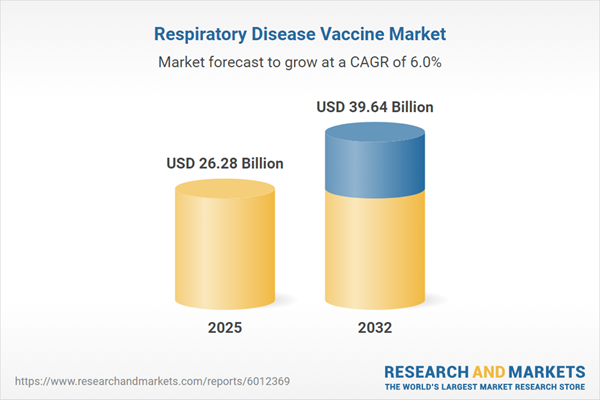Speak directly to the analyst to clarify any post sales queries you may have.
The respiratory disease vaccine market is undergoing significant transformation as healthcare organizations manage evolving risks, embrace technological innovations, and adapt to policy shifts. Senior decision-makers must consistently assess strategic priorities to ensure operational resilience and maintain competitive positioning in this dynamic environment.
Market Snapshot: Respiratory Disease Vaccine Market
In 2024, the global respiratory disease vaccine market is valued at USD 24.78 billion, with projections indicating growth to USD 26.28 billion in 2025 and USD 39.64 billion by 2032. The market demonstrates a compound annual growth rate (CAGR) of 6.04%, supported by intensive research and development activity, adaptive supply chains, and the accelerated implementation of advanced platforms. Vaccine developers and related organizations are strengthening innovation pipelines, promoting widespread immunization, and adopting resilient business strategies to accommodate new disease trends and regulatory landscapes.
Scope & Segmentation of the Respiratory Disease Vaccine Market
- Vaccine Type: Conjugate, inactivated, live attenuated, mRNA, subunit, and viral vector vaccines each play a distinct role in expanding coverage and improving resistance to a range of respiratory illnesses.
- Age Group: Solutions are targeted for infants, children, adolescents, adults, and older adults, ensuring protection across all demographic groups and supporting life-course immunization planning.
- Distribution Channel: Channels include direct procurement, hospital-based supply, digital retail options, and pharmacies to maximize reach and streamline vaccine distribution in varied settings.
- End User: Public hospitals, private clinics, home healthcare providers, and research facilities form the foundation for vaccine administration, especially among high-risk and geographically dispersed populations.
- Route of Administration: Vaccines are delivered through intramuscular, intranasal, oral, and subcutaneous methods, creating flexibility for providers and facilitating patient access based on clinical recommendations.
- Geographic Coverage: The market is active across the Americas, Europe, the Middle East and Africa, and Asia-Pacific. Each region navigates different regulatory, infrastructure, and public health frameworks, influencing local uptake and adoption strategies.
- Key Companies: Industry leaders such as Pfizer Inc., GlaxoSmithKline plc, Sanofi S.A., Seqirus Pty Ltd, Moderna Inc., AstraZeneca plc, Johnson & Johnson, Novavax Inc., BioNTech SE, and Sinovac Biotech Co. Ltd. are expanding global capabilities. They foster collaborative R&D efforts and drive reliable supply through partnership and innovation.
Key Takeaways for Senior Decision-Makers
- Adoption of mRNA and viral vector platforms enables greater agility in responding to emerging diseases and supports compliance with shifting regulatory expectations.
- Integrated digital logistics capabilities enhance inventory tracking and distribution, mitigating the risk of supply shortages in hard-to-reach areas.
- Public-private partnerships facilitate seamless rollout of immunization initiatives and ease entry into regions with complex regulatory demands.
- Strategic allocation by customer group, distribution method, or care environment helps tailor immunization solutions to localized needs while maximizing program impact.
- Robust supply networks reduce operational disruption, ensuring continued access to critical vaccines for vulnerable populations.
Tariff Impact: Navigating Policy and Production Resilience
Recent changes to tariffs in the United States have contributed to higher costs and increased complexity within the vaccine supply landscape. Organizations are responding by prioritizing domestic sourcing, diversifying their supplier base, and engaging regulatory and trade experts to maintain stable procurement and reliable delivery.
Methodology & Data Sources
This analysis draws on structured executive interviews, verified industry databases, and systematic clinical literature reviews. Comprehensive market intelligence produced through these methods offers data-driven guidance for leaders within the respiratory disease vaccine market.
Why This Report Matters
- Provides executives with a practical structure to align technology innovation, supply resilience, and regulatory strategy for future growth.
- Delivers critical intelligence on market catalysts and supports competitive benchmarking against evolving industry standards.
- Empowers organizations to anticipate shifts in regional healthcare needs and proactively adjust operations as market pressures change.
Conclusion
A well-defined understanding of the respiratory disease vaccine market equips organizations to respond effectively to evolving demands and secure lasting achievement of organizational objectives in a rapidly shifting sector.
Additional Product Information:
- Purchase of this report includes 1 year online access with quarterly updates.
- This report can be updated on request. Please contact our Customer Experience team using the Ask a Question widget on our website.
Table of Contents
3. Executive Summary
4. Market Overview
7. Cumulative Impact of Artificial Intelligence 2025
Companies Mentioned
The companies profiled in this Respiratory Disease Vaccine market report include:- Pfizer Inc.
- GlaxoSmithKline plc
- Sanofi S.A.
- Seqirus Pty Ltd
- Moderna, Inc.
- AstraZeneca plc
- Johnson & Johnson
- Novavax, Inc.
- BioNTech SE
- Sinovac Biotech Co., Ltd.
Table Information
| Report Attribute | Details |
|---|---|
| No. of Pages | 184 |
| Published | October 2025 |
| Forecast Period | 2025 - 2032 |
| Estimated Market Value ( USD | $ 26.28 Billion |
| Forecasted Market Value ( USD | $ 39.64 Billion |
| Compound Annual Growth Rate | 6.0% |
| Regions Covered | Global |
| No. of Companies Mentioned | 11 |









